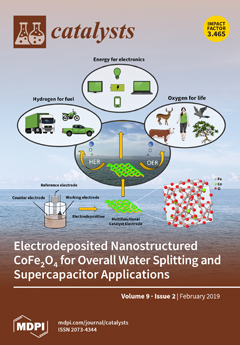Palm waste biochar (PWB) catalysts were synthesized as bio-based catalysts using different sulphonation methods. (NH
4)
2SO
4, ClSO
3H, and H
2SO
4 were applied to functionalize PWB and appraise the discrepancies between the sulfonic agents, as they affect the esterification reaction in terms of fatty acid methyl ester (FAME) yield and conversion while using palm fatty acid distillate (PFAD) as feedstock. The PWB was first soaked in phosphoric acid (H
3PO
4) for 24 h and then pyrolized at 400 °C for 2 h in tube furnace. Afterwards, sulphonation was done with different sulfonic agents and characterized with thermo-gravimetric analysis (TGA), Brunauer-Emmett-Teller (BET), Fourier transform infrared (FT-IR), X-ray diffraction (XRD), field emission scanning electron microscopy (FESEM), energy-dispersive X-ray (EDX), and temperature programmed desorption–ammonia (TPD-NH
3). The three synthesized catalysts showed high free fatty acid (FFA) conversions of 90.1% for palm waste biochar-ammonium sulfate (PWB-(NH
4)
2SO
4), 91.5% for palm waste biochar-chlorosulfonic acid (PWB-ClSO
3H), and 97.4% for palm waste biochar - sulphuric acid (PWB-H
2SO
4), whereas FAME yields were 88.6% (PWB-(NH
4)
2SO
4), 89.1% (PWB-ClSO
3H), and 96.1% (PWB-H
2SO
4). It was observed that PWB-H
2SO
4 has the best catalytic activity, which was directly linked to its high acid density (11.35 mmol/g), improved pore diameter (6.25 nm), and increased specific surface area (372.01 m
2 g
−1). PWB-H
2SO
4 was used for the reusability study, where it underwent eight reaction runs and was stable until the seventh run. PWB-H
2SO
4 has shown huge promise for biodiesel synthesis, owing to its easy synthetic process, recyclability, and high catalytic activity for waste oils and fats.
Full article





